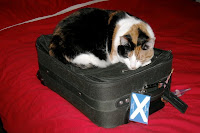 I have a ton of questions about these otters caught hanging out - and I have none at all. Their holding hands just makes sense, you know?
I have a ton of questions about these otters caught hanging out - and I have none at all. Their holding hands just makes sense, you know?
Two days ago I ran across an actual note to self: “Mother Maya says, “What are your questions?” Intrigued as to why I’d copied this enigmatic remark, I put it in a new pile. But her question wouldn't let me go.
As I talked with lots of people and met lots of other animals, I thought about the questions we were all asking, or repressing: the chestnut mare obsessed with a patch of clover; the greyhound, lamed by being raced; the seven parakeets left homeless along with their owner; and the happy cocker spaniel that greeted us at the park this morning. What questions apply to our shared lives? What questions were we human caretakers asking and which were we avoiding?
I came up with a few. My first caution, dear reader, is that they are not easy ones. The second caution is that my answers are works in progress – as your own might be. But these questions did lead me back to something important, and I hope you’ll be encouraged to ask your own.
First, what does it mean to “own” another being? Increasingly, as Adam Gopnick so beautifully explored in a recent New Yorker article about becoming a dog owner, there’s clearly more than “ownership” in play for many of us who share our lives with other animals. But not for all of us. What’s our moral obligation when we take on this responsibility? Do we adequately prepare, financially and in other ways, for a rich and happy life and for the old age of our pets?
Is there such a thing as a “good death,” and if so, what does it look like?
Few beings, I believe, want to die, so in that sense I’d say no to the first part of the question. But I also know that when a being begins dying he or she starts a journey that only they can take. Death’s essence is aloneness – which is hard and haunting, especially for the survivors. On the other hand, when my father was deep inside a coma, he knew we were present and could hear us because he told us when he recovered. So I believe that even in a dying state, the presence of others is known and can be comforting.
For me, as for many beings, a good death is a natural and peaceful one, with little or no pain, in the presence of those I love. A good death also means making time to express your love, to remember, and to hold on to one another.
Another aspect of a good death is the opportunity to come in our wholeness to this new experience. Asking for forgiveness, speaking our love and our care, sharing happy memories, sacred times, and letting go of regret – these acts bring wholeness to any relationship. I want to come to death, mine or a beloved’s, filled with loving-kindness: scars, warts and all, but one.
It turns out that Mother Maya is an extraordinary woman who recovered from ovarian cancer to become a healer of body, mind and spirit. She speaks all over the world about the need for spiritually grounded healing practices in order to remove pain and suffering from the world – the earth and all beings. What does she say about healing ? “It's about knowing that each and every being must be helped into wholeness. Only then can we become whole in ourselves.”
Our purpose in life is to bring about wholeness of all beings. That’s a purpose to ponder – to enable the full “beingness” of others. And that is how I answer my last question, which is, “Why are we here?”
Mother Maya’s question about questions is important when we think about the other beings we bring into our lives. We bring wholeness to them through our bringing non-violent, life-affirming intentions to our treatment of all beings, and we live into our own wholeness this way.















